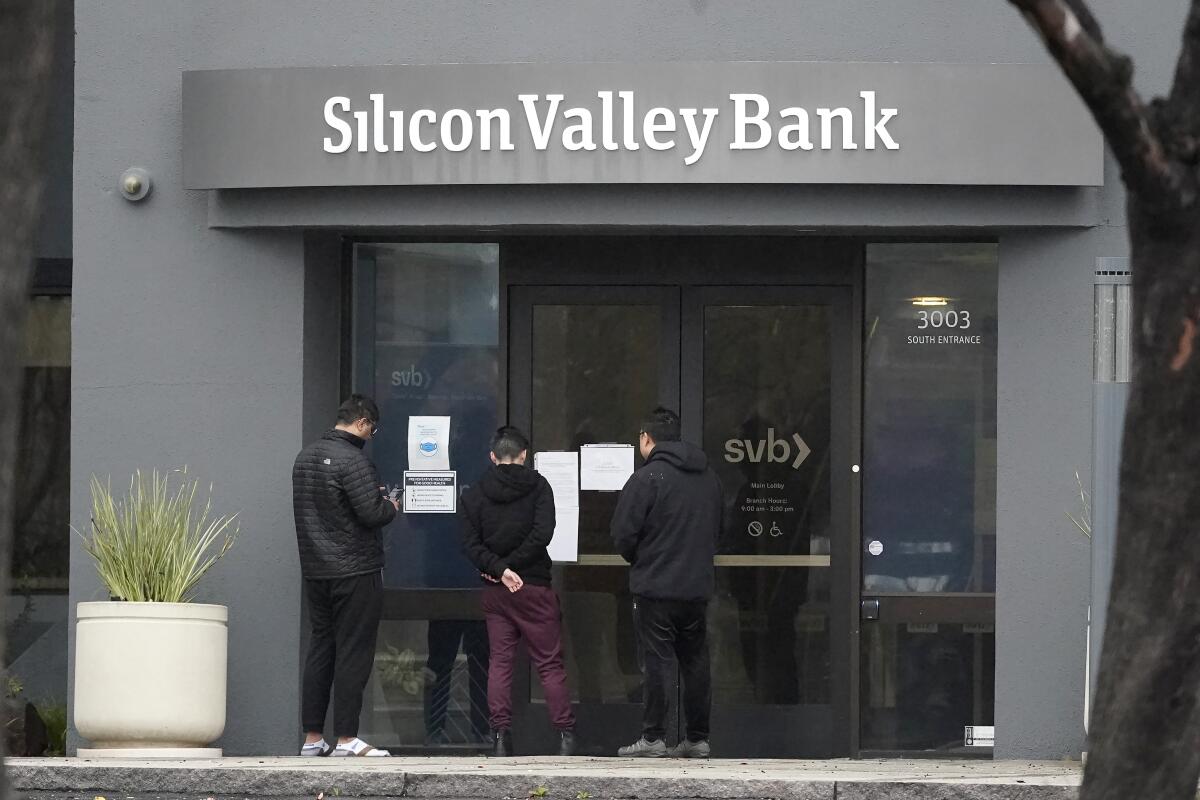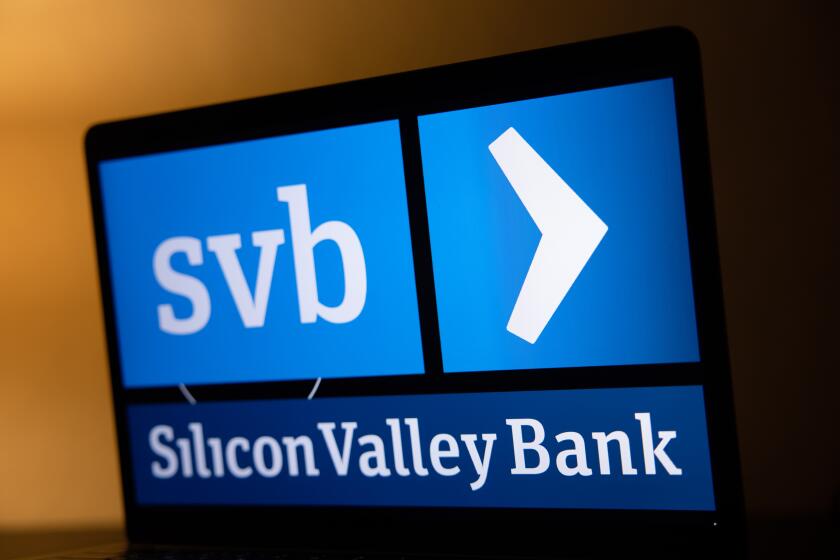Silicon Valley Bank’s collapse sparks mad scramble and fears of wider chaos

- Share via
“Stay calm.”
That’s what Greg Becker, chief executive of Silicon Valley Bank, told clients Thursday morning on a conference call, hastily convened to assure them the Santa Clara institution was confident it would weather a liquidity crunch.
Update:
11:33 a.m. March 12, 2023This article has been updated to clarify the timing of Stripe’s cash advance offer to business customers, which was not instituted as a response to the closure of Silicon Valley Bank.
By the end of the day, as high-profile venture capital firms urged their portfolio companies to get their money out, the bank had seen withdrawals of $42 billion. It was a full-fledged bank run, a coup de grâce against one of the tech industry’s central institutions fomented by some of its loudest boosters. The second-biggest bank failure in U.S. history, after the collapse of Washington Mutual in 2008, has raised the specter of widespread layoffs at startups and broader instability in the U.S. financial system.
Tech company founder Sara Mauskopf was nearly part of that rush for the exits. By the time she attempted to wire a small amount of funds out of her account Thursday, the bank had closed for the day. The transaction was pending Friday morning, when the California Department of Financial Protection and Innovation shut down SVB and put its assets into receivership with the Federal Deposit Insurance Corp.
“I didn’t see it coming at all,” Mauskopf said.
Countless companies around the country have finances entwined with SVB in some way, including loans and cash sweep accounts. The bank, which caters to tech, venture capital and private equity firms, had about $209 billion in assets at the end of last year, according to the Federal Reserve, making it the 16th largest in the U.S.
Silicon Valley Bank became the biggest U.S. bank failure in more than a decade, after its long-established customer base of tech startups grew worried and yanked deposits.
Now those companies must wait anxiously to find out whether and when they’ll be able to retrieve funds in excess of the $250,000 limit guaranteed by the FDIC, a scenario that could require further government intervention.
Mauskopf, founder of child-care startup Winnie, said she’s banked with SVB since her company’s inception in 2016. She’s unable to access funds needed to operate her business, including making payroll.
“When you can’t guarantee employees will be paid on time, it really impacts people,” Mauskopf said.
Even companies that don’t directly bank at SVB could run into obstacles to paying employees as a result of its failure. HR management company Rippling used the bank to run its payroll services, CEO Parker Conrad wrote on Twitter. It has since switched to JPMorgan Chase & Co., but payments initiated earlier in the week could be delayed, Conrad said.
SVB’s woes stem from the sharp rise in interest rates that began last year and undermined the profitability of its large bond position. The acute phase of its crisis began Wednesday when it sold a large portion of its securities at a loss of about $1.8 billion after tax to make sure it could cover deposit withdrawals and set out to raise $2.25 billion in capital. As shares dropped in response to the news, customers smelled financial weakness and began pulling their money out to avoid getting stuck with losses.
The FDIC has said all depositors will have full access to their insured deposits no later than Monday. But only 12.5% of its $173.1 billion in deposits were insured as of the end of 2022, according to the bank’s annual report.
The Silicon Valley Bank failure is the old story of what happens when short-term depositors want their money back from a bank with only long-term assets.
Jessica Mah, who founded the accounting software company inDinero, said she has many customers with SVB accounts, including one with just shy of $100 million in deposits there. Some business owners are considering personally funding payroll if they cannot access capital by then, Mah said.
Uninsured depositors will get a receivership certificate for the remaining amount of their uninsured funds, which may be paid back in the future as the FDIC liquidates SVB’s assets.
It’s possible the federal government, concerned about possible contagion to other banks, will step in before then to guarantee all SVB’s deposits. Mauskopf said it’s not about whether “rich VC [venture capital] funds deserve some sort of bailout,” but about whether businesses can pay their bills with the money they’ve earned.
“I just want to make sure people understand this has a real effect on real people that aren’t wealthy,” she said.
Some financial services companies that cater to startups, including Stripe and Brex, are making funds available to companies like Mauskopf’s in certain cases.
Brex is offering an emergency bridge credit line for SVB customers funded by third-party capital, the company wrote on its website, Mauskopf said, and Stripe is offering a cash advance on future revenue to some customers, an offer that predates the SVB crisis.
One tech founder based in Los Angeles said he wasted no time in moving money out of SVB as soon as he heard about the stock drop and was able to recover 85% of his company’s funds, though his company still has several million dollars left in SVB.
He also invests in startups through AngelList, a major platform for launching venture funds. Because AngelList banks with SVB, the capital he has through it is frozen as well.
While many observers agree that SVB probably would’ve been able to weather its liquidity crisis had customers not attempted to withdraw deposits all at once, the tech founder said there was no incentive for people to show patience.
“There’s zero reason to keep your money in there because the downside risk, even if it’s 0.1% … is you lose all your money,” he said. “I just don’t want to be part of the last ones standing.”
William Hsu is co-founder of L.A.-based venture capital firm Mucker Capital, which has hundreds of companies in its portfolio that bank with SVB. Hsu said he’s concerned about the potential ramifications of the bank’s collapse throughout the venture capital, tech and startup spheres over the next weeks and months.
“I’m very worried about my portfolio companies and how they’re going to make payroll. I’m very worried about the employees that work for my companies,” he said.
There are also legal ramifications to not paying employees, which could lead to mass layoffs as companies unwillingly let workers go.
Hsu is looking for other sources of capital not tied up with SVB to bridge his companies for the next payroll.
Friday’s events probably will also cripple the venture industry for months as the companies it backs struggle to stay afloat, Hsu said.
“That’s a lot of capital that stops going into the economy,” he said.
Times staff writer Lindsay Blakely contributed to this report.









